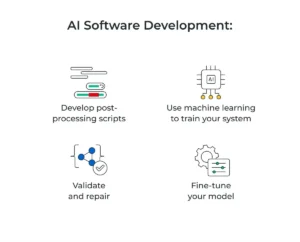Want to impress your investors or customers? Your own AI software could be your answer. It automates tasks, improves decisions, and speeds up business growth. Many companies now use AI to analyze customer behavior, predict sales trends, and automate marketing.
As entrepreneurs, we see the huge potential in investing in AI. We have built AI software for our clients and know the hurdles firsthand. In this blog, I will break down 7 steps to create AI software, explain why investing in AI is worthwhile.
Why Is AI Software Worth Investing In?
Here are the top three reasons why building AI software is a prime opportunity for tech and non-tech startup founders:
Building AI solutions creates more value for users.
Stay competitive in the market by providing better customer experiences.
High profit margins arise from automating repetitive or time-consuming tasks.
According to Accenture, AI could double the economic growth rate of some developed countries by 2035. The global AI market is expected to reach $126 billion by 2025.
How To Build AI Software: 7 Steps
Let’s discuss how to build AI software. While the process resembles developing any software application, there are additional steps. Here are 7 main steps to create AI software from scratch:
Identify the specific problem you want to solve with AI.
Collect relevant data to train your AI model.
Clean and format data for effective training.
Choose AI technology for your project.
Develop the model and train it using your data.
Test the model.
Implement the model in a real-world setting.
Step 1: Identify the Specific Problem You Want to Solve with AI
The first step to developing AI software is identifying the problem you want to solve. It requires more than just an innovative idea. You need to research thoroughly to understand the challenges. How do you create artificial intelligence? AI software is created according to specific requirements.
This step helps you choose the right AI technology for your project. From machine learning to natural language processing or computer vision, a clear problem leads to effective solutions. During our discovery stage, we utilize the best strategies to move from problem to solution before proceeding to the next step.
Step 2: Gather Relevant Data
The next step is collecting data. This part is crucial in any AI model development process. To train an AI model, you must have a large amount of data based on your project requirements, such as text, audio, images, and other formats.
Collecting data involves more than just amassing information. Ensure that your data is relevant, high-quality, and well-structured. This is vital when considering how to create AI that truly addresses user needs.
Step 3: Clean and Format Data for Effective Model Training
After collecting data, the next step is to clean it. This is an essential part of creating an AI tool. Most data is unstructured and complex. You must transform, clean, organize, and manage data to train your AI model effectively.
Remember, the quality of your data directly impacts your AI model’s overall performance. Retraining is necessary whenever you add or modify data. Although time-consuming, this step is vital for AI development.
Step 4: Choose an AI Technology
Once you have gathered your data, it’s time to select the AI technology that aligns with your goals. Here are a few options to consider:
Machine learning
Speech recognition
Natural language processing
Augmented reality
Each of these technologies offers unique benefits and can be tailored to how to build an AI solution for your specific needs.
Step 5: Develop the Model and Train It Using Your Data
This step involves complex processes requiring expertise in AI and data science. Don’t worry, though; there are no-code AI platforms available. These platforms let you create your own AI software to sell without writing a single line of code.
Simply upload your data, and let the platform handle the training process. Here are some no-code AI platforms for you:
Google Cloud AutoML: Ideal for tasks like image classification, text classification, and natural language processing.
Amazon SageMaker: Offers a no-code solution for building AI models, including image classification and NLP.
Microsoft Azure Machine Learning: Allows you to develop AI models for tasks like image and text classification without needing to write code.
These platforms simplify AI model development, allowing you to leverage powerful technology without technical expertise.
Step 6: Build and Test the Model
Training AI models is crucial in AI development. This process involves feeding data into the algorithm and adjusting parameters to minimize errors. Data scientists typically use 80% of the dataset for training, while the remaining 20% is set aside for validation to test the model’s predictive power.
During this phase, it’s essential to split your data into training and validation sets. This ensures accurate model performance assessment. Additionally, choose metrics to evaluate your model’s effectiveness. Common metrics include:
Precision
Accuracy
Recall
F1-Score
Selecting the right metrics gives you a clear picture of your model’s effectiveness and areas for improvement. If you’re unsure about how to make an AI program, these metrics can guide your testing process.
Step 7: Implement the Model in a Real-World Setting
Once your model is trained and performs well, you’re ready to deploy it for real-time use. Deployment depends on your project requirements, whether you’re creating a web application or integrating the model into an existing system.
During deployment, consider:
Security: Ensure data privacy and safeguard against potential threats.
Scalability: Make sure the model can handle increased demand as usage grows.
Performance: Optimize for efficient processing and response times.
After deployment, regularly track and monitor the model’s performance in a live environment.

Key Takeaway
Building AI software is challenging, but the right approach can yield transformative results. Whether you’re launching an AI-powered startup or adding AI to your product, Code Genesis is ready to support you. Get in touch with us today to learn more about AI development services. Let’s bring your ideas to life and create a lasting impact together!
FAQ
Can you build your own AI?
Yes, you can build your own AI software! All you need is high-quality data. You can develop AI models through various methods, including no-code and low-code platforms, AutoML, or traditional programming.
How to develop software AI?
To develop AI software, follow these key steps:
Train the Model: Use your data to train the AI model and optimize its performance.
Validate the Model: Test the model’s accuracy and effectiveness using fresh data.
Deploy the Solution: Integrate the trained model into your software application.
Monitor and Refine: Continuously track the model’s performance in real-time and make improvements as needed.
This process ensures your AI software is accurate, effective, and adaptable over time.
What software is used to build AI?
To build AI, developers commonly use a range of tools, including:
Python
TensorFlow and PyTorch
NLTK and spaCy
OpenCV
Jupyter Notebooks
Scikit-learn
Keras
Docker
How is AI software made?
To create AI software, follow these steps:
Identify the Problem: Define the specific problem the AI will solve.
Collect Data: Gather relevant, high-quality data for training.
Create Algorithms: Develop algorithms tailored to your problem.
Train the Model: Use the data to train and optimize your AI model.
Choose the Platform: Select a platform or tools (such as TensorFlow or PyTorch) for development.
Pick a Programming Language: Use a language like Python, which is popular in AI.
Deploy and Monitor: Implement the AI system, monitor its performance, and make adjustments as needed.
Following these steps helps ensure a well-rounded and effective AI solution.